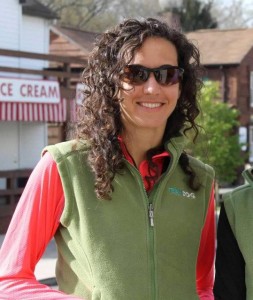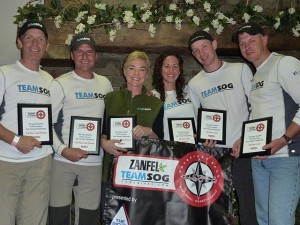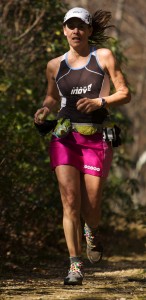 In the July/August 2015 Issue of Endurance Racing Magazine, we will catch up with Robyn Bennincasa and her organization, Project Athena.
In the July/August 2015 Issue of Endurance Racing Magazine, we will catch up with Robyn Bennincasa and her organization, Project Athena.
Please subscribe to Endurance Racing Magazine to help support the July/August Women’s Issue
An Amazon Hear: Love Beyond Winning
By Chelsea H. Bryan
“I’ve been an athlete since I was a kid: gymnastics 4 hrs a night/6 days a week, track, diving, cross country in high school. Then diving at ASU, followed by triathlons when my new sales job brought me to Ironman mecca, encinitas, ca. I did my first Ironman at 23, then completed 7 Ironman distance races and 3 Konas by the time I was 28 or so. Then the bug hit me to try to go even longer, as that seemed to be my strength. When I read about Adventure Racing in Runners World, I knew that it was the sport I was meant to do with my not small body and my lifetime of multisport training. Not to mention the desire to be part of a world class team. I tried out for the female spot on Mark Burnett’s racing team in 1994, and then ended up on an all-female team racing against him in the Raid Gauloises in Borneo. The rest is history, 40+ expedition races later, with the best teams in the world.” —Robyn Benincasa
When Robyn Benincasa came to the end of her career as a top-ranking world adventure racer, she thought she’d give paddling a whack. “I knew I was okay, but I didn’t know that I really had a talent for it.” That talent surfaced in her first race, a 460-mile paddle from White Horse in Yukon, Canada, in which she placed third as a solo paddler and eighth out of the total 110 boats in the race.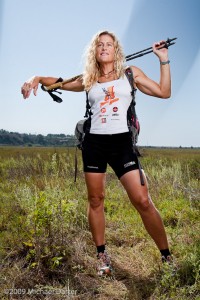
Hidden talent soon became record-breaking talent. A year later on the Missouri River, she went 330 miles and set the course record. The world record for flat water in October 2010 took the stakes to Guinness World Record–level, and she didn’t stop at one. She took the world moving water record in June 2011.
“I raced with Robyn on Team Merrell from 2008 to 2012. Most notably, she was the team captain and the ‘glue’ for the team. We competed at the World Championship in Brazil in 2008 and finished 2nd at Primal Quest Montana in 2008, which was the biggest race in North America at the time. … Robyn is one of the most experienced athletes (male or female) when it comes to adventure sports. She has won big races, including the Eco Challenge, and she’s a compelling and inspirational leader.” —Travis Macy, Benincasa’s former teammate
“Now I’m going for open water,” says Benincasa.
The tour de force Amazon in the water started as a world-class adventure racer who completed over 40 expedition races in 16 years, one of the few who swam in class three and four whitewater rapids back when the sport was less-regulated; a woman whose lowest lows and highest highs were spent scrambling over hills cold and wet in the middle of the night, and getting through physical, emotional, spiritual and mental trials with the selfless aid of teammates. “When you’ve been really successful at a point, it’s hard to be out of the top five,” says Benincasa. Of course she and teammates were still holding spots in the top five, a testament to her drive, athleticism, and—as Benincasa emphasizes—teamwork.
Benincasa was also plagued by a different obstacle than her usual challenges of traversing staggering distances and rugged terrain at breakneck speed with few resources and almost no sleep: she was facing her first hip replacement.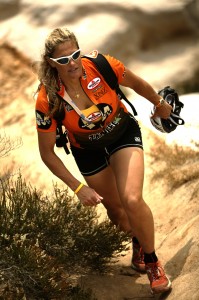
“So I started doing what I normally do, which is put some stuff on the calendar so I have something in my future to keep me from falling into deep depression … to keep your spirits up and keep yourself focused.”
Benincasa noticed that her friend, Louise, was keeping herself centered in much the same way—by creating a horizon to journey forward to. “My friend Louise was going through chemo … she was this little bald girl, but she was always like, ‘Well, I have to be ready, I’m climbing Kilimanjaro, I’m climbing Denali.’ She said breast cancer gave her that drive even more.”
“I have known Robyn for many years. I met her at the first Eco Challenge in 1995. She was amazing and hard-core then and she is still amazing and hard-core now. Hard-core meaning ‘strong, fit and beautiful’ on the inside and outside.” —Former teammate Lisa Smith Batchen
Louise’s cancer and Benincasa’s hip inspired a brilliant idea: Benincasa would help other people in the same way she and Louise were helping themselves stay positive. In a phrase, they would, as Benincasa now so often says, “Inspire other people to amaze and inspire themselves.”
That dream materialized in Project Athena, a nonprofit that takes survivors of disease and injury, true overcomers and survivors, and sends them on expeditions to fulfill long-held dream accomplishments. For those who don’t have a specific dream race or location, Athena sends them on group endurance expeditions. “Gods and goddesses” are Project Athena fundraisers who race alongside survivors, the very people for whom they are raising research and cure funds. Someone raising money for cancer research and participating as a goddess may paddle along with a Leukemia survivor. It’s the ultimate motivation to give of all your resources to help another—and redefines the word “team.”
“Everyone is equal in that there’s the same result, you’re watching people have those moments … that sense you can do anything, with the right team,” she said.
MY LIFE NOW:
“I train alone a lot these days due to my crazy schedule.
After having 4 hip replacements in 4 years, from 2007-2011 I turned into more of an ultra paddler and ultra cyclist than a runner. I have a dry land kayak trainer on the apparatus floor at my fire station, and I train on it all afternoon between calls. I have two of the 4 Guinness world records for longest distanced paddled in 24 hours by a female (flat water and moving water) and I’m going to go for the open water record this spring.
In my spare time, I have a corporate team building business that does 40-60 keynotes/year for fortune 1000 companies and run the Project Athena Foundation between shifts at the fire station on my all chick crew.
In my life, there is never dull moment. I have a boyfriend of 14 years whom I met in the fire academy and we do everything together. He even comes with me on the road. We see our house 2-3 days a month, so no kids, just a hibernating desert tortoise.”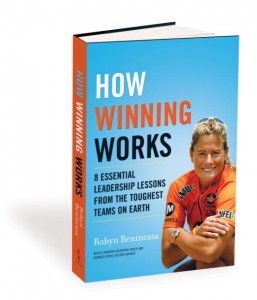
And Benincasa knows about teams. In describing some of her best experiences, she says, “It has to be a team where everyone cares about the others as much as themselves. These moments where it’s just literally one heart and one mind—sharing everything, your food, your heart … my most memorable [times] are really the ones where you’re crying and someone says just the right thing. I don’t think any other sport has that—where you’re together, that in-depth and that much on the razor’s edge.”
The weight of Benincasa’s times of total exhaustion in the competition utterly pale in comparison to the joys of team unity those trials brought. It seems to have taught her a lot. “You can’t be at the top of your game as an athlete forever and I think you have to get to that point where you have to give back.” That, she says, is the reason she started Project Athena and what keeps her going during competition.
“We provide coaching, entry fees, world class teammates, travel, gear–everything they need to make that transition from Surivor to Athlete!” —Robin Benincasa
ALLI MORGAN, AN ATHENA IN HER OWN RIGHT
The first time her doctors mentioned the word “amputation” to 20-year-old Alli Morgan, she was in the hospital for a skin graft—one of many she’d had over the previous five years since tearing her ACL in a field hockey game in her sophomore year of high school.
At first, in the months following her ACL surgery in October of 2005, everything had seemed fine—Alli had undergone the operation the common injury requires, and it seemed life would go on normally. But then Morgan was suddenly unable to progress in physical therapy due to intense pain. Months later, she found out that the screws holding her reconstructed ligament in place had migrated into the joint space, and that her ACL was too long. She underwent a second surgery to replace the ACL, but a Staph infection set in post-surgery and, as Morgan says, “This was the point at which my life really began to revolve around my medical care.”
The incision that had reopened with the Staph infection refused to close, and Morgan became septic on many occasions. “I was constantly in and out of the operating room for wound debridements, skin grafts, and other orthopedic procedures. A significant portion of my high school years were spent in the hospital,” says Morgan. Doctors had mentioned amputation before, but always as a worst-case scenario—never as a real possibility of recovery.
Though Morgan had had many skin grafts, none had taken; and while in the hospital for yet another, her doctor looked at the skin above her 61-square-inch wound and told her that they were going to take some skin from the thigh above it because they had run out of skin on her left leg. They mentioned that they didn’t want to take too much, though, in case she ever had an amputation. Morgan began contemplating the word less as horror and more as possibility.
“[The word amputation] had such power at the beginning, but now I throw it out there and it’s no big deal. It was always that distant threat, I never thought it would be a solution,” Morgan says. “By the time I turned 20, I had been on crutches for five years, had undergone 40 surgeries, and although I had proved to myself that I could handle the mental and physical demands that came with my condition, I realized that it was time to take control over my life. I recognized that I had found a powerful sense of hope and faith through the adversity I faced, and it was through that hope for the future that I knew that ‘getting my life back’ involved having my leg amputated.”
Morgan had heard about Project Athena in 2009 and applied for an Athenaship. She got it, and was sent a bike in 2010. However, she was unable to participate at the time, as her health only deteriorated. Seven years and 46 surgeries later, she had gotten rid of everything holding her back and became a Florida Keys Athena, cycling 129 miles from Key Largo to Key West with three other Athenas.
“My leg was dead weight. Dead weight that needed daily dressing changes, pain medication, blood transfusions, and surgeries to keep from wreaking havoc with the rest of my body. Once I began to research the idea of amputation, the thought became liberating. As counterintuitive as it may seem, the thought of losing my leg gave me hope for my future. … I called Robyn and I said, ‘I’m getting rid of it.’”
The amputation was finalized in October of 2011, and, like Benincasa, Morgan referred to her final surgery as a beacon of hope: “It was very powerful that I was making this decision. I was putting a date on the calendar … it was the first time I felt I had control.”
Over a year later, Morgan has gotten her life back and more. In the first week of March, she became the first United States Female Adaptive Skeleton athlete and first Female Adaptive Bobsled Brakeman. She is training for the Paralympic 2018 bobsled races, skiing on an adaptive biathlon team, and doing road and mountain biking while training for her first century ride in May. She plays sled hockey recreationally, and also climbs at a gym to keep her leg in shape.
Like Benincasa, Morgan used her deep desire to use her body fully to motivate her through her medical journey. During long hospital stays, she dreamed of being outside; she watched the Tour de France and Kona Ironman on TV as forms of therapy: “As reminders that I would be able to reclaim my body and mind.”
The deepest part of the Athena experience for Morgan is the community of athletes’ recognition that not only the body is reclaimed, but the whole person.
“You lose a sense of your personhood. But this was a chance to reclaim that … These people got it, they get that you don’t just fix the body, you fix the soul. Project Athena really stood for that and it was through athletics, which is even better. You need your team with you … such an inspirational group of people all at once who understand that.
“I dream about being able to make a difference in the ways that so many others have helped me. I dream of being able to share my experience and how it has rekindled my hope with those who may need it. The Project Athena Foundation is about reclaiming your sense of self through the support of a team of people who understand your pain, your passion, your perseverance to keep pushing.”
To learn more about Project Athena and to get involved, go to http://www.projectathena.org/.
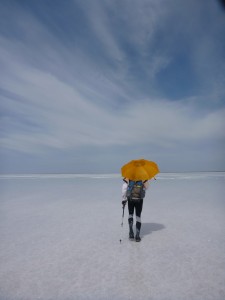 Expedition adventure racing is something of a brutal sport. Competitors typically race through a course of about 500kms over 4-7 days. Throughout the world there are a series of races that make up the toughest and most respected races around, comprising the Adventure Racing World Series. Australia’s one and only expedition race, XPD, stands as a behemoth. It is consistently longer than any other race in the world series, and is renowned as being one of the toughest races of any sort – period. The 2013 race, the Geocentric-run XPD covered 750kms with a course duration of up to 9.5 days. My team – Outer Edge Racing – raced for just over six days, trekking, running and mountain biking for about 22hours a day through the Australian outback and Flinders Ranges.
Expedition adventure racing is something of a brutal sport. Competitors typically race through a course of about 500kms over 4-7 days. Throughout the world there are a series of races that make up the toughest and most respected races around, comprising the Adventure Racing World Series. Australia’s one and only expedition race, XPD, stands as a behemoth. It is consistently longer than any other race in the world series, and is renowned as being one of the toughest races of any sort – period. The 2013 race, the Geocentric-run XPD covered 750kms with a course duration of up to 9.5 days. My team – Outer Edge Racing – raced for just over six days, trekking, running and mountain biking for about 22hours a day through the Australian outback and Flinders Ranges.
By Navigation Expert, Rohan Kilham
It all began 3 months before the race. I assembled an all-male team and we began a very belated training program focusing on trekking at speed, mountain biking on semi-technical terrain and paddling. It is a salient aspect of all adventure races that the course and maps are revealed just prior to the race start, meaning we were none-the wiser as to which discipline would be the most important.
Six weeks out from the race Sean – the team hard man – pulled out due to work commitments, leaving us to find another member. Queenslander Bec Wilson stepped up, and with only a few weeks to go, we changed our entry to the premier mixed division. It is a curiosity of Adventure racing that the world’s best teams are invariably mixed rather than all male. Indeed in some races only mixed teams are permitted to race – so it was nice to now have a team in the most competitive division.
The race HQ was at Port Augusta, South Africa. Here we attended competency checks, gear checks and briefings. Race bibs were handed out and 20 hours prior to our scheduled departure, we were given our maps. The next day 30 teams from Australia, New Zealand, Papua New Guinea, Japan and Brazil boarded coaches for the race start – the remote Arkaroola.
The race start was preceeded by a ceremony for two adventure racers from team Real Discovery who dies tragically in a sea kayaking accident. After a solemn few minutes on top of Accacia ridge teams followed Real Discovery down to the race start before beginning a 30km rogaine in almost 40 degree heat.
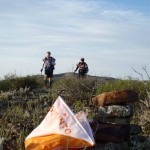 Our team had planned a course through several gorges with some relatively straight forward navigation over several hills and creek-beds. In the stifling heat we slashed our way through sharp undergrowth to the beginning of 20km Gorge. Sweat dried as fast as it soaked my arm-pits and neck, the sun was relentless as it scorched our skin and blistered our lips. After some 4 hours or so we found our first water; a small muddied pool with a dead wallaby on its periphery. We dove in immediately, savoring cold fluid on hot flesh but needed to move on quickly. We ran for a while tussling with the Bivouac Colts and Team Mawson for 3rd place. But as we hit the first transition area, we were in 4th place hot on the heels of the Bivouac Colts.
Our team had planned a course through several gorges with some relatively straight forward navigation over several hills and creek-beds. In the stifling heat we slashed our way through sharp undergrowth to the beginning of 20km Gorge. Sweat dried as fast as it soaked my arm-pits and neck, the sun was relentless as it scorched our skin and blistered our lips. After some 4 hours or so we found our first water; a small muddied pool with a dead wallaby on its periphery. We dove in immediately, savoring cold fluid on hot flesh but needed to move on quickly. We ran for a while tussling with the Bivouac Colts and Team Mawson for 3rd place. But as we hit the first transition area, we were in 4th place hot on the heels of the Bivouac Colts.
We assembled our bikes and headed off into the sunset, but Roland’s chain broke. We fixed the chain and rode through Wooltana station – a flat, arid cattle station of red dirt and bull dust dotted with the pastel greens of saltbush.
The sun slowly set behind us as we rode on, but soon thereafter, Dan began to struggle. He began slurring his words and slowing considerably. He started vomiting and needed a tow. Fortunately, he perked up after an hour or so, but the strain of dehydration and exhaustion were there. We navigated conservatively and moved back to 3rd place. We rode through the night using by lights we travelling some 48kms without a single hill until we found ourselves pushing through soft cattle tracks on bull dust and needed to walk our bikes. After several Km of hiking in bike shoes on the soft red sand we made it to our next transition on the edge of Lake Frome.
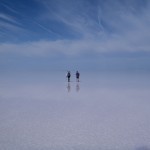 We had no real idea of what this leg would entail. All we knew was that it was a 50+ Km trek on a salt lake. Again we chose a conservative route as we navigated our way to a checkpoint in the middle of several thousand square Km of salty nothingness, before navigating south to the checkpoint. We forged a way though sand dunes and saltbush we hit the lake – a surreal almost 2 dimensional landscape of pure white.
We had no real idea of what this leg would entail. All we knew was that it was a 50+ Km trek on a salt lake. Again we chose a conservative route as we navigated our way to a checkpoint in the middle of several thousand square Km of salty nothingness, before navigating south to the checkpoint. We forged a way though sand dunes and saltbush we hit the lake – a surreal almost 2 dimensional landscape of pure white.
The surface of the lake was like concrete; hard, lightly textured and dead flat. We very carefully set a bearing for our first checkpoint, navigating on a totally moonless night without a single landmark or contour to help. The experience was a little nerve-wracking. It was crucial we stayed on our bearing if we were a little off, we could walk straight past it.
 Eventually morning broke, revealing our position. It was like a surreal dream. On all sides was eternity of flatness. The horizon ended in a 360-degree uninterrupted juncture of pale blue and white – no hills, no landmarks and no clouds. After several more hours of trekking we came across an ‘island’ a patch of sand amidst the white. We rested our feet for a while and assessed our situation. The salt was as abrasive as it was intrusive. It had worn its way into our shoes and socks and was causing some savage blisters. Our toes, heels and the balls of our feet were swollen and sore. Blood oozed from toenails, diluted by the leaking serous fluid of engorged blisters. We taped our feet as best we could, had some breakfast and carried on for another 15hours.
Eventually morning broke, revealing our position. It was like a surreal dream. On all sides was eternity of flatness. The horizon ended in a 360-degree uninterrupted juncture of pale blue and white – no hills, no landmarks and no clouds. After several more hours of trekking we came across an ‘island’ a patch of sand amidst the white. We rested our feet for a while and assessed our situation. The salt was as abrasive as it was intrusive. It had worn its way into our shoes and socks and was causing some savage blisters. Our toes, heels and the balls of our feet were swollen and sore. Blood oozed from toenails, diluted by the leaking serous fluid of engorged blisters. We taped our feet as best we could, had some breakfast and carried on for another 15hours.
As the afternoon overtook us we slowed considerably. Bec had begun to vomit due to heat stroke and we were forced to rest with 10 Kms of white salt to go. Of the 30 litres we had brought we had little more than 5 left. We forced 500 mls down Bec’s throat and dripped small amounts of what was left on her neck, head and chest, trying to cool her down. Eventually we were able to set off again. The challenges didn’t stop however. As we headed south we very quickly came across water. It was so hyper saline that it could not dissolve any of the salt that made up its edge – nor could it evaporate easily. With no way of knowing what lay beyond, nor where the waters edge might lie, we forged away straight through it. For 5kms we trapsed through ankle, then knee deep water before arriving at the lake edge. We pulled into the next TA some 20+ hours after beginning. Bec was near collapse, and my mind was shot from focussing on a compass bearing and blank horizon for 20 hours without a break. We agreed to dress our blisters and sleep for 3 hours – a full 24 hours before we had originally planned.
Taking off our shoes was like a horror show. Blisters distorted our feet as if we were deformed. Skin flapped from our toes and heels while blood and serum literally dripped to the ground. Popping our remaining in-tact blisters with a knife was a gruesome task. Like puncturing and overfull sack of pus, they sprayed their contents over our clothes and legs. It was grotesque. The balls of my feet were now detached, my heels – particularly my right – was comprised of a 10 cm flap of wet skin, I had lost the feeling in several toes, some of which were being held together with white tape. The other guys were all missing toenails – casualties of swollen feet – and sported a similar array of skin flaps.
Reality came crashing down. There was very little chance of us finishing a further 140 Kms of trekking with feet like this. Our race was probably over. Earlier on we had jokingly agreed that it would be the finish line or death. Now, with doomed feet, the chance of finishing seemed elusive at best. We agreed that we would go until we physically could go no further. Though we were now racing to survive rather than racing for a place, we agreed we’d keep going until we broke. We were despondent at the thought of pulling out – more so in the knowledge that it would probably be at the beginning of the next trekking leg.
The three hours of sleep we had worked wonders. We got up at about 9 pm and set off several hours later. We had been deliberately slow, having given up on being competitive. However it seemed as though some sort of miraculous recovery was underway. Though we hobbled in pain in our bike shoes, once we were up and racing the pain in our feet subsided. We pushed on with surprising ease astride our trusty two-wheeled steeds.
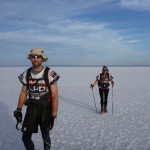 Leg 4 was another long flat leg of bull dust and salt bush. Finding the navigation simple we set a fast pace to head into the next transition. It was a relief to be free of the monotony and lethargy of the salt lake, and we raced through the night regaining some lost time in the cool dry conditions.
Leg 4 was another long flat leg of bull dust and salt bush. Finding the navigation simple we set a fast pace to head into the next transition. It was a relief to be free of the monotony and lethargy of the salt lake, and we raced through the night regaining some lost time in the cool dry conditions.
The following leg was a formidable one. It was a 40 Km trek over three small mountain ranges with some difficult navigation on almost featureless plains. Deciding we had nothing to lose we forced our swollen pulped feet into running shoes and set off. I was eager to get as much done in the light of day as we could, knowing that the navigation got harder and harder the further west we went. Our progress was slow – no more than about 2 Km/h – but it was constant. As we hobbled through the day we picked up several more checkpoints before arriving at a water drop.
Here we donned lights, drank deep and prepared ourselves for the hardest navigation of the course. We set off at our slow deliberate pace, Bec slowed a little by her wrecked feet and a new pain developing in her thigh. We wound our way up dry creek beds, paying careful attention to the match of creek direction and map direction. Then we traversed several slopes to a series of mountain tops before coming to our checkpoint in a saddle. Following a crude bearing we then worked our way to a highpoint, then a wide river bed then up several more creek beds to where I thought our next check point would be but after 2 hours of searching it couldn’t be found. Till now my navigation had been solid – as the team’s sole navigator I felt I’d done well – but now, lost in the wilderness it felt like I was wasting everybody’s time. We agreed that we’d sleep for 2 hours and head off just prior to sunrise in search of the mystery checkpoint. The night was clear and cold. We spooned for warmth, shivering beneath a stunning black moonless sky. After 2 hours of frigid rest we roused – just prior to sunrise. We found the checkpoint only a little way north, before we headed into Blilnman – population 22 – for the next TA.
Here we redressed our deteriorating feet and prepared for a straight forward mountain bike. But the trek had damaged our feet more than we could have imagined. Roland and Dan had to cut large swathes of fabric from their bike shoes in order to accommodate their feet. Furious at the imposition, unrelenting agony and the sense of wasted time, Roland set off at a furious pace with Bec on tow. For 30 minutes we set a maniacal pace down bitumen before heading onto some 40kms of dirt on our way into the famous Wilpena. We slowed our pace out of necessity to something more manageable as the heat overtook us and Roland calmed. The next few hours saw us blitz some 7 teams in the space of several hours as we cruised into Wilpena in one of the fastest times in the field. It became the hallmark feature of our race. Fast bike legs followed by agonisingly slow trekking legs.
At Wilpena we wasted time in setting off for the spectacular trek up St. Mary’s peak. It was a relatively straight forward 28km trek on formed paths but we were reluctant none-the-less. Our feet – Becs and mine especially – were excruciatingly sore. We set off via the public toilets – relishing the chance to use a proper toilet for the first time in 4 days. The trek itself was a slow wander through Wilpena pound. Being night we missed the views, catching instead an ink-black sky, littered with a thousand stars, unadulterated by the pale touch of moonlight. Exhaustion was evident. Roland had begun to hallucinate, seeing faces and animals on the track, and Dan was literally falling asleep on his feet. At times he would lurch to one side, as he almost fell asleep while walking.
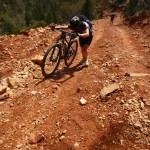 As the track climbed and fell it became evident that Bec was struggling. We stopped for a brief rest, and took extra weight from Bec. Stoic as ever though she was keen to push on, at times even attempting a horrible deranged hobbling run. With less than 10 Kms to the TA we would normally have jogged it in 1.5 hours, however as the pain and lethargy overtook us we found it taking us more than double that. From time to time Bec was doubled over, vomiting in pain. Even though we had done all we could, leaving Bec with less than a kilogram of weight to carry, I couldn’t help but feel useless – unable to help a faultering team mate.
As the track climbed and fell it became evident that Bec was struggling. We stopped for a brief rest, and took extra weight from Bec. Stoic as ever though she was keen to push on, at times even attempting a horrible deranged hobbling run. With less than 10 Kms to the TA we would normally have jogged it in 1.5 hours, however as the pain and lethargy overtook us we found it taking us more than double that. From time to time Bec was doubled over, vomiting in pain. Even though we had done all we could, leaving Bec with less than a kilogram of weight to carry, I couldn’t help but feel useless – unable to help a faultering team mate.
Pushing on to the next transition was a pretty gutsy effort on Bec’s part, and it was a huge relief to get to the transition knowing we had done the majority of the trekking. We took 2 hours of sleep in the early morning then jumped on the bikes for a short sprint to a roping section 400m above the ground. We made short work of the 20kms overtaking several teams along the way. From there we headed up to Moonarie, a world renowned rock climbing area, where we ascended ropes to the next checkpoint. It was a brilliant setting. Dangling high on a vertical, almost overhanging wall of blank red rock, I relished the outrageous exposure and spectacular panorama. Despite our position, I felt as calm and relaxed as I had for the whole race. No stranger to rope-work, it was a delight to be free of the bike and trekking poles, if only for a while.
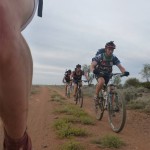 The final push to mid camp was tiring. We pushed hard, knowing that so long as we were on the bike, we were capable of splits in the top 3. It was an exhausting leg though. After several more flats, we came to a steep hike-a-bike. Overcome with the pain in my feet I lagged behind the team as I slowed considerably. In the end Roland had to carry my bike the final few hundred meters up the hill, while I suffered as silently as I could on the ascent. The stiff soles of my bike shoes had slowed me to a crawl, and I felt guilty at holding my team mates up. The roads that made up the following legs didn’t match the maps particularly well at all. From here we bashed our way across country to the next checkpoint, before finding the trail again. After several hours we arrived at Hawker. Here we had a compulsory 6 hr stop. We ate, recharged batteries and attempted to sleep in the baking afternoon sun. Overcome with flies and heat, sleep was a long time coming. We woke at around 8pm to re-dress our feet and head off on a 150km mountain bike leg to Wilmington. Our timing had been a mixed bag. Though we lost sleep in the middle of the day, languishing in our hot windless tent, we were now riding during the cool of night, meaning we had to carry less water and would be less likely to succumb to heat stroke.
The final push to mid camp was tiring. We pushed hard, knowing that so long as we were on the bike, we were capable of splits in the top 3. It was an exhausting leg though. After several more flats, we came to a steep hike-a-bike. Overcome with the pain in my feet I lagged behind the team as I slowed considerably. In the end Roland had to carry my bike the final few hundred meters up the hill, while I suffered as silently as I could on the ascent. The stiff soles of my bike shoes had slowed me to a crawl, and I felt guilty at holding my team mates up. The roads that made up the following legs didn’t match the maps particularly well at all. From here we bashed our way across country to the next checkpoint, before finding the trail again. After several hours we arrived at Hawker. Here we had a compulsory 6 hr stop. We ate, recharged batteries and attempted to sleep in the baking afternoon sun. Overcome with flies and heat, sleep was a long time coming. We woke at around 8pm to re-dress our feet and head off on a 150km mountain bike leg to Wilmington. Our timing had been a mixed bag. Though we lost sleep in the middle of the day, languishing in our hot windless tent, we were now riding during the cool of night, meaning we had to carry less water and would be less likely to succumb to heat stroke.
Ultimately the leg was fairly uneventful. Our feet performed well on the bike legs, and during this leg in particular, navigation was straight forward. We pushed through only slightly slower than the winning team – mountain designs. Just before sunrise I bonked. My legs and body were shot from the 300kms of riding thus far. Somehow though, the sun started a revival, and an hour later I was firing on all cylinders again. Then only 5kms out from the transition Dan began passing out – almost collapsing mid-ride. Dan’s ‘engine’ was unique. He literally required calories every 10 minutes. Despite weighing a paltry 60kgs, he ate more than any of us. It took some fine tuning, but in the end he found a winning formula in the form of Hammer Perpetuem solids: small chalky puks worth 33 calories a pop. One of these every 10 minutes while riding seemed to keep him in remarkable shape. During our 450+ Kms of riding, Dan towed Bec for about 300 of them! We took a few minutes out before pushing on to Willmington.
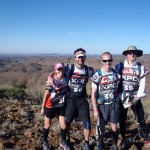 Here we learnt that fierce winds had cancelled the final leg – an 87 Km paddle. Instead a 60 Km mountain bike replaced the final 2 legs. It was a bittersweet ending. Paddling was one of the legs that defined adventure racing. Not paddling felt like cheating. But paddling was also our weakest link, meaning that we had a chance to make up a spot or two in the final leg.
Here we learnt that fierce winds had cancelled the final leg – an 87 Km paddle. Instead a 60 Km mountain bike replaced the final 2 legs. It was a bittersweet ending. Paddling was one of the legs that defined adventure racing. Not paddling felt like cheating. But paddling was also our weakest link, meaning that we had a chance to make up a spot or two in the final leg.
Before that however, the final 50km trekking leg remained – a wandering course through the foothills of Mt Remarkable, then up and over Mt Remarkable itself and down into the small town of Melrose. We resumed our 2kmph pace again picking up several easy checkpoints along the way. All the while we were chowing down on anti-inflamatories and pain killers at maximum dose. As night fell Dan, Roland and Bec began to falter, they stumbled along talking about the snakes on the ground and lights in the trees. Not for the first time this race Roland was hallucinating from tiredness. We bunked down for 2 hours at Scarfes hut. We simply couldn’t justify any more sleep this close to the finish. Heading off again we ascended a 5km ridgeline to a small plateau and the final off-track checkpoint, hidden in a creek bed. Becs feet and leg were ailing, and at times Dan and I had to physically carry her while Roland carried the extra gear. Slung between us we would carry Bec down hills in order to speed up the team.
Roland and Bec were doing it tough though, and as we wandered across a high plateau beneath the summit of Mt Remarkable they began literally falling asleep on their feet. Roland would sway dangerously, while Bec, supported by Dan had her eyes closed, staggering through the undergrowth. At one stage she admitted not remembering the previous hour despite picking up one of our final checkpoints. Struggling to stay awake and to move fast Dan carried Bec for the remaining parts of the 50km trek in an attempt to speed up our progress.
But we were still painfully slow, and 15kms from the end of the trek we found ourselves caught out in the very early hours of the morning. High on the trek, the usually hot weather took a surprising turn, pelting us with strong winds and rain. With people near collapse and hypothermia a real possibility we pushed on to a shelter where we slept for 3 more hours. We spooned for warmth, our mandatory 400 g sleeping bags simply not cutting it in 5 degrees and wet. As the sun dawned we put on wet clothing, ate as much as we could and trekked the final few Kms to Melrose.
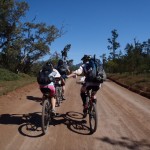 We were one leg from the end. A 60 Km bike ride on bitumen. At the transition we discovered we were an hour behind Team Goldfish and 2 hours behind The Muppets. Backing our biking abilities we hurried to catch them. 20 minutes after arriving we hit the tarmac with blistering pace. We set a pace line and pushed hard. We had to make up about 15kms in a 60kms leg just to make up one place! After a frantic 3 hours we did it. We caught Team Goldfish on the outskirts of Port Augusta and hurried to the finish line.
We were one leg from the end. A 60 Km bike ride on bitumen. At the transition we discovered we were an hour behind Team Goldfish and 2 hours behind The Muppets. Backing our biking abilities we hurried to catch them. 20 minutes after arriving we hit the tarmac with blistering pace. We set a pace line and pushed hard. We had to make up about 15kms in a 60kms leg just to make up one place! After a frantic 3 hours we did it. We caught Team Goldfish on the outskirts of Port Augusta and hurried to the finish line.
No sooner had we overtaken them, than the guilt of pipping someone at the post after 750kms – for 9th place no less – overtook us. We stopped on a corner and waited for Goldfish to arrive. Then at last we crossed the finish line as two teams. Exchanging much deserved congratulations.
In the days following our feet have undergone an odd metamorphosis. For my part the pain of walking subsided as flaps of skin dried up and fell off. Sleep calls me all day long. My body wants nothing more than to lie down and rest. But it will subside. And I know that soon I’ll be training again, desperately hanging out for the next race.
Side bar:
 LAKE FROME IS A SALT LAKE THAT FILLS ONCE EVERY 30 ODD YEARS. THERE WAS A SMALL STRIP OF ANKLE-DEEP, HYPER-SALINE WATER AT THE SOUTHERN EDGE, BUT FOR THE MOST PART IT WAS BONE DRY. THE SURFACE WAS A ROCK-HARD SALT CRUST THAT WAS DEAD FLAT. THE CONDITIONS WERE SO HARSH THAT NO PLANT-LIFE, ANIMALS OR INSECTS CAN LIVE ON OR AROUND THE LAKE.
LAKE FROME IS A SALT LAKE THAT FILLS ONCE EVERY 30 ODD YEARS. THERE WAS A SMALL STRIP OF ANKLE-DEEP, HYPER-SALINE WATER AT THE SOUTHERN EDGE, BUT FOR THE MOST PART IT WAS BONE DRY. THE SURFACE WAS A ROCK-HARD SALT CRUST THAT WAS DEAD FLAT. THE CONDITIONS WERE SO HARSH THAT NO PLANT-LIFE, ANIMALS OR INSECTS CAN LIVE ON OR AROUND THE LAKE.
“We are the number-one team in North America, ranked fifth in the world, just won our Nationals, have never been worse than second place in any race we did in the world this year. It’s been a fun ride with a great team, and we’re having fun going fast and pushing the envelope of human endurance.”
– Earring Doug Judson – Tecnu Adventure Racing
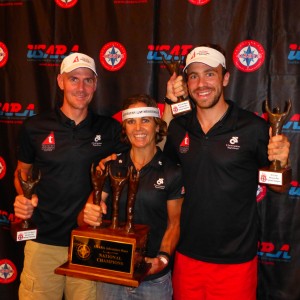 Team Tecnu Extreme Adventure Racing continues their dominating year with a tremendous win against 55 of the best adventure racing (AR) teams in Indiana at the USARA National Championships in October.
Team Tecnu Extreme Adventure Racing continues their dominating year with a tremendous win against 55 of the best adventure racing (AR) teams in Indiana at the USARA National Championships in October.
Tecnu dominated the race early on and won by the biggest margin in AR history, finishing early Saturday morning in 19’20 – a full 2:05 over the second-place finishers (also from the west coast in Dart/Nuun). Kyle Peter, Bob Miller and Karen Lundgren of Tecnu were excited and relieved to have won the race; Tecnu experienced three close second-place finishes the past three years, and they were glad to finally get the win.
“This win means a lot to our team. It is the culmination of poetry in motion, and watching the best three team members we have work in unison to not only win the USARA Nationals, but to dominate and win it by over two hours. Winning was a big weight off our back because we were no longer wasted potential, and our goal we had each year had finally come to fruition,” said Peter, team captain.
Team Tecnu has been racing at the USARA National Championships for the past four years, only to be disappointed with the runner’s-up position every time until this past month.
“We have traveled from the Laurel Highlands of Pennsylvania, to the Cumberland Falls of eastern Kentucky, to the hills of New Paltz, New York, and finally found victory in the rolling hills of southern Indiana,” Peter said.
The USARA Championship race has attracted the most competitive AR squads from around the country for the past 13 years, and it’s not just another 24-hour adventure race; it is the one race every year where teams put their strongest squad forward in the quest to be crowned the best team in US adventure racing. This title makes all those early-morning wakeups, cold bike rides, wet kayak paddles, and hours of travelling to races worth it. Team Tecnu did all of that and more for four years to reach this goal. It was an extreme effort, which paid off.
“We know the bull’s-eye is on our back going into 2014, but we relish the idea of working hard, and defending our hard-earned title, and not allowing the perpetual trophy to leave our sponsor’s hands. With our last goal of 2013 being getting on the podium at the World Championships next month in Costa Rica, the team will board the plane with the confidence that we are peaking at the right time. And with a little luck, and some stellar navigation, this year’s hard work will have paid off,” Peter said.
Note: Team Tecnu is leaving for the Adventure Racing World Championships in Costa Rica on November 27 as a co-favorite to podium, ranked Number Five in the world and tops in North America. The Championships are held December 2-12; the winner is expected to take approximately 5.5 days.
]]>
By Todd Parker, MA, MS
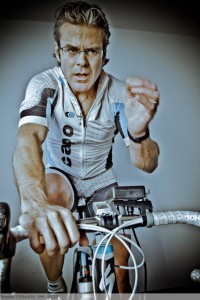 Magnesium is a mineral, like sodium, calcium, and potassium, which all are important to maintaining electrolyte balance in our bodies. Magnesium, however, is often overlooked as a mineral which plays critical role in cramp prevention. In fact, muscular contractions could not consistently occur without magnesium’s presence. Because it plays such an important role as our bodies produce energy, it is important to work toward maintaining healthy levels of magnesium.
Magnesium is a mineral, like sodium, calcium, and potassium, which all are important to maintaining electrolyte balance in our bodies. Magnesium, however, is often overlooked as a mineral which plays critical role in cramp prevention. In fact, muscular contractions could not consistently occur without magnesium’s presence. Because it plays such an important role as our bodies produce energy, it is important to work toward maintaining healthy levels of magnesium.
Magnesium imbalances can be caused by things such as diuretics (e.g., caffeine) and alcohol consumption. As with most endurance exercise, longer and more intense exercise can deplete magnesium levels, which can lead to cramping.
Biochemically speaking, as we exercise, magnesium aids our bodies to utilize oxygen. Therefore when magnesium gets depleted through exercise, electrolytes must be replenished for the body to produce the energy which fuels us during intense exercise.
For athletes, especially those training and racing in endurance sports, magnesium deficiency indicators can include one or more of the following:
- abnormal muscular weakness
- muscular cramping and “locking”
- muscular spasms
- impaired glucose breakdown (for ATP/energy production)
- inability to sustain exercise intensity for extended periods
- irregular heartbeat (e.g., elevated performance heart rate)
- disorientation and confusion
You can get magnesium into your diet with unrefined whole grain breads and cereals, green leafy vegetables, lentils, peas, beans, nuts, and seeds. Meat, fish, fruit, dairy products, and processed foods are poor sources of magnesium.
Magnesium is excreted primarily through sweat and urine; therefore, cold fluids (which empty out of the gut faster) are the preferred choice for replenishment during exercise. Conversely, excess magnesium is filtered by the kidneys; however, if overly excessive, kidney function is adversely affected. When this occurs, just as with a deficiency, side effects may surface in the form of muscular spasms, and as I call it, muscular “locking”. Through proper monitoring, athletes can supplement with 300-900 mg per day without contraindications. Larger dosages, as in 700-900mg, should be broken up into 2-3 doses throughout the day with food. Female athletes should supplement at the lower end of this range, and don’t normally require any dosage above 300-400mg. Increases in oxygen uptake, no matter how minor, could (for example) improve a cyclist’s sustained power output, which can facilitate improved performances.
If you’re an endurance athlete or you exercise for long periods or with extremely high intensity, look for beverages that not only have calcium, potassium, and sodium, but also contain magnesium. If you’re cramping during longer training sessions or races and have ensured that the other three minerals are being replenished, there’s a good chance what you’re experiencing is attributable to low magnesium levels.
Todd Parker is a former Professional Triathlete and holds a Masters in Exercise Physiology from San Jose State University. He is an exercise physiologist, certified cycling and endurance sports coach, strength coach, and personal trainer. You can reach Todd at [email protected]
]]>
By Yuhan Xu
Julia Pollock had been a competitive swimmer since the age of five. After graduating college, she became interested in adventure racing – and she has since participated in nearly 100 races, including Endorphin Fix, Mega Dose, Beast of the East, Odyssey One Day, Primal Quest San Juan Islands and USARA Nationals. She’s now 32, an avid adventure racer and on TeamSOG of American Adventure Sports. She shares with ERM her stories of adventure racing and her belief in racing as a lifestyle.
I was a competitive swimmer from age five to 21. When I graduated from college and ended my swimming career, I decided I was done with competition; I had competed my entire life and just wanted a break from the expectations. But it only took about three or four months for me to realize that I really missed the team aspect as well as the competition.
So I went looking for something that was competitive while still being fun. Competitive swimming requires an intense regimen of physical and mental training that provides a natural transition into adventure racing. I have been involved in adventure racing since 2002; but I have to admit that it was not an easy transition, having been in the water all my life and then moving to a high-impact sport like endurance running. My legs, knees and hips fought it fiercely—they still do. I’ve done a couple of ultra marathons in the past, but usually just for training. Adventure racing really is the sport for me, because it combines all the things I love about athletic competition. Shuttle me to the start line of a marked swim, bike or run course? No, thanks. Drop me off in the middle of the woods with a map, a compass, a couple of my best friends and tell me to find my way home? You’re on!
What I love most about adventure racing is that it teaches you something new about yourself every day. It’s amazing to experience how your mind works through and ultimately overcomes the mental and physical challenges. It’s enlightening. It’s hard to really explain—you have to experience it yourself…and once you do, you’ll be addicted.
You’ll see things in adventure racing that you would otherwise never get the chance to experience. Standing on a knife ridge at dawn as the sun illuminates virgin wilderness for as far as the eye can see; taking a shower in a waterfall that’s so remote it took three days to hike there; dropping down into a slot canyon that is otherwise off-limits to typical tourists—you’ll go places and see things in adventure racing that you’d never get any other way.
One of the great things about adventure racing is that every race is completely different, and it’s not always the fastest team that wins. That being said, adventure racing has gotten a lot faster over the last decade…and even more so since its inception almost 30 years ago. As we learn more and more about how far we can push our bodies, and as equipment becomes more and more technical and lightweight, athletes are able to break boundaries of human performance. It’s quite amazing—sleep deprivation, pain tolerance, endurance thresholds—the human body is amazing. The human mind is amazing! So much of adventure racing is mental—it’s pretty spectacular what the brain can will the body to do.
I’ve probably competed in 75 to 100 races over the past 11 years, all over the world, from six hours to 10 days—that adds up to a lot of mileage! I wish so much that I’d kept a journal and logged all the miles I’ve raced. I’ve had every experience from not finishing a race, to losing a teammate and continuing unranked, to standing on top of the podium. I’m lucky enough to say that it’s been more of the latter lately, but that’s not always the case.
My favorite win? Odyssey One Day in 2009. TeamSOG was at that time Team NatureCure. We raced so hard for 24 hours, and the finish was on a blind curve. When we came around that curve, we saw Team Odyssey coming in as well from an equal distance on the other side. We both spotted each other at the same time—and all of a sudden, it was a mad sprint to the finish line. Literally eight people dove across the line simultaneously, and we ended up in a tangled mess of bodies and bikes. Oh my, we all laughed so hard. They called it a tie, and I can’t think of a better team to share the podium with. They’re all such great people.
That’s the other thing that makes adventure racing so amazing—the people! You’ll never meet a more genuine, fun, kind-hearted and just plain beautiful group of people. They love life, and they want to squeeze every drop of it out of their lifetime. They really appreciate the beauty of every day. We compete against each other, but ultimately we’re competing against the course and for the love of the sport. We really are all the best of friends and are happy to see others succeed.
TeamSOG is what keeps me going. I can exercise on my own, I can live without the competition; but I really, really love the community that comes with being on a team. I have so much respect for my teammates. Often in a race I keep going not because I want to, but because my teammates deserve to finish the race and to place well. They give me inspiration and I love them so much. And of course there’s the old saying: “Fall in a mud puddle by yourself, and it sucks. Fall in a mud puddle in front of your friends, and it’s hilarious.”
When it comes to training, I don’t view it as “training”. I look at it as living a healthy lifestyle. I just don’t sit still well. I stand when I watch TV. If I don’t get outside at least a few hours a day, I go nuts. So everything is training to me. And that’s one of the things about adventure racing—everything is training. Just being on your feet for long periods of time is good adventure racing training. I run, walk and ride every chance I get.
I run a normal amount during the workweek—45 minutes to an hour and a half depending on my work schedule; and on the weekends, we try to run or ride for two to four hours a day if not longer. We used to spend weekends going out for 12- to 24-hour workouts—Saturday morning to Saturday night or Sunday morning—but life’s gotten so busy, it’s hard to find a free weekend to do that anymore. Also, in adventure racing, racing is training; many of the eight- to 12-hour races we run prepare us for the 30- to 72-hour races. There’s really no other way to train for the longer races. It’s also important to mix it up: running, riding, yoga, climbing, paddling. It adds variety and prevents overtraining in any one discipline.
TeamSOG members live in many different locations, so we don’t get a lot of opportunities to train together; but we try. I often run by myself or with my partner, Doug Crytzer. Occasionally we’ll meet up with a small group for a bike ride on the weekends, but a lot of the training is solo. I always love company and I appreciate it every chance I can get it, but I think solo training is very healthy. It’s my meditation time; it gives me the opportunity to reflect and clear my head of all the nonsense that we experience in everyday life. There are many times I have to force myself out the door early in the morning or on a bad weather day, but I’m always so happy I did it. I’ve never regretted it.
I work full-time as a risk analyst for a bank in Pittsburgh, Penn. I live with Doug, and we share time with his beautiful nine-year-old daughter, Calla. She keeps us running even more than we usually are. We spend as much time outside as we possibly can—gardening, riding (bikes and horses), running, fishing, farming—the list goes on.
It’s nice to have a partner who races as well, because we support each other’s training schedule and learn from each other all the time. Doug is an amazing individual, and I am so lucky to share a life with him. He inspires me daily with his vision and his appreciation for the simple beauty of life. It adds so much to my own outlook on why I do what I do. It helps to have a person in your life who is not just active, but who also understands what adventure racing is and has experienced it (and its ups and downs). It helps to talk all of that through with someone who really understands what’s going on in your head—and find the lessons in each experience.
Adventure racing really breaks you down and makes you think you can’t keep going. You have to search for that inspiration; and you’ll find it in a number of different places—your teammates; the sunrise after a long, cold night; a field full of flowers; a beautiful mountain stream; a rare animal sighting on the trail. Life is everywhere. Just breathe in and you’ll realize that life endures every day.
The overarching theme here is that this is not just a sport, it’s a lifestyle—a choice of lifestyle. It doesn’t start when you cross the start line, nor finish when you cross the finish line. It is present every day. If you don’t believe it in your heart that all of this is good for you—the exercise, the competition, the people, the diet, the sunshine, the interaction with nature—then you’re really missing the true experience and the value of having it.
]]>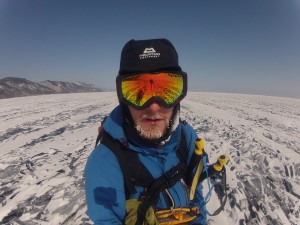
Benn Berkeley
Adventurer Benn Berkeley has returned from the world’s first Siberian Black Ice Race
Benn Berkeley walked 208 miles in 5 days and 6 hours on frozen Lake Baikal in Siberia. He didn’t see anyone for days on his trek, during which he fell through the ice and battled against horrendous weather and extreme cold.
“I vomited for eight hours and walked in the dark for five hours in the wrong direction. It was painful, desperate and cold; but there was nowhere else I’d rather be – I loved it and I don’t know why.”
– Benn Berkely
ERM: Tell us what it was like trekking across Siberia.
BB: The wind has been howling at you for 18 hours, the view hasn’t changed, your destination doesn’t seem to be getting any closer and the rhythmic sound of spikes scraping across questionably thick ice starts to grind on you. When I signed on to the inaugural Siberian Black Ice Race, I imagined the romantic ideal of polar exploration and travel in a beautiful wilderness. I couldn’t have been further from the truth.
Just getting there was an experience in itself. My first port of call was the airport, where I met most of the other competitors. Once everyone arrived, we embarked on a miniature adventure trying to safely get ourselves and our bags other things to Siberia. Everyone was on full alert, trying their best to avoid the inevitable overweight baggage charges that airlines use to keep themselves in business. It was a tense wait at the other end, pondering over what might have happened to your bag in transit and whether it would ever come through on the conveyor belt. Luckily for everyone, the bags arrived safe and sound.
ERM: How old were you when you made that first step to go to ultra distances? What drove you over the edge?
BB: Racing has never been at the forefront of my interests. It has always been about the challenge. Any kind of endurance feat will involve a lot of preparation in terms of training, research and diet, and for a single event this can involve months of hard graft for a relatively short burst of pain and suffering at the end of it all. So it comes as no surprise that many people don’t understand the point of endurance racing or a similar challenge. But I don’t believe you can understand it until you have put yourself through it.
I have many dreams and ambitions, and most of them seem to be punching way above my weight. The Siberian Black Ice Race was just that. I received a newsletter from Extreme World Races, advertising places available for a race in Siberia. I immediately began looking into it, and before I knew it I had booked my place and had five months to prepare. I had no previous racing experience, but I had plenty of cold weather experience with mountaineering and ski touring.
I don’t regard myself as an athlete, but I’m willing to give most things a shot; and I believe that you don’t need to be superhuman to achieve the seemingly impossible. I have never lacked the confidence to try something new (which is both a good and a bad thing). This race was something new for me and I suffered greatly – but what I learned outweighed the suffering tenfold.
I’ve always been fascinated by feats of endurance, and I thought that this race would give me a good idea what I’m made of. I often read stories of mountain epics, polar expeditions, ocean rowing adventures, and wonder whether I could do that. It’s all too easy to sit down in a comfy, warm home reading about a near-death ordeal and think to yourself, “Yeah, I reckon I would’ve survived that.” So presented with the question, What drove you to do this race?, I would say it was my test piece. A chance to see how I’d cope with sleep deprivation, freezing-cold temperatures, painful injuries and no one there to encourage or help me when I really needed it. I wanted to relate to these stories of hardship and determination.
ERM: Tell us about your mental training. It takes a certain mental fortitude to do this sport. What drives you and keeps you sustained during competition?
BB: Mental training is a very odd thing, and it is something I haven’t really got my head around. The mind is a weird and wonderful place that has the ability to give you incredible strength when you really need it. I struggle to take advice on mental preparation, as everyone is different and it is me and me alone who knows how my mind works. I don’t think you can train yourself to be stronger mentally; I think when you are pushed to the limit, your mind takes over and does what it needs to do. For example, when I fell through the ice in Siberia, there was no rational thought process. I was tired, I had been walking for hours on end, I was cold and in pain – and then I plunged through the ice into freezing-cold water. At that point it was survival; my mind and body did what they had to do, and I didn’t even think about it – and that is the beauty of it. I couldn’t have trained for that (unless you count that experience as training), but the advantage I gave myself was to start the race feeling fit and healthy.
ERM: Tell us a little about your training, who you train with and why, and what products you use (clothing/food/equipment, etc.) in your training and in competition.
BB: Training can be a very scientific thing, and that has extremely great benefits but can put a very rigid schedule into your life. I weighed why I was doing this race, and it wasn’t to gain a podium spot – it was to see how I coped with it and to have a great experience. So with this in mind, my training wasn’t a strict step-by-step regime. I would train when I could, fitting it around work and my life. I would make sure that when I trained I would train hard, and never go in with the attitude that I’ve earned a rest day or I’ll have an easier session. If I didn’t have the time to put in a complete training session, then I would reduce the time and up the intensity. I sometimes found myself getting bored of repeating the same exercises, so I’d change them up regularly. If I didn’t enjoy what I got out of the training, I wouldn’t see the point; so I kept my self interested and kept the training varied. For example, tire hauling is a very boring and mind-numbing experience; but it is fantastic exercise and specific for the race I was doing. So instead of doing X amount of miles dragging tires, I would vary it. One day I would pick two spots on the map and draw a straight line between the two, and try to drag/carry/throw the tires across the line with the mindset of not deviating from the line. You’d be surprised how difficult it is to get a couple of tires through a very thick and very large hedge!
For food, I eat what I like. I enjoy food and feel that if I work hard enough, I can have what I want. The last thing I want to do is get back from a massive training session not looking forward to eating.
I see a lot of nice training clothing, but unfortunately I’m not made of cash. I will train in anything, it doesn’t bother me too much. Sometimes I do walk past a nice sports shop and look in the window at some nice training shorts or performance T-shirts and I get tempted. I tell myself that it doesn’t make a difference. If that doesn’t work, I resort to my secret weapon: I’ll remind myself that old explorers achieved a great deal wearing gear that wouldn’t even be worn to a fancy dress party because it would be too heavy and uncomfortable!
ERM: Do you budget for your competitions each year?
BB: I have worked in many jobs, most of them minimum wage. I save money to spend on adventures and try to be fairly frugal while I’m working so that I can enjoy my time when I’m not. There’s no secret to it; I work hard for a period of time until I have the money to go somewhere else or do something else. Two things in my experience stop people doing things: money and time, Luckily, they are two things that you can change in your life. First, budget and save. It’s easier said than done, but if you really want to do something you have to make it happen. Second, if you don’t have enough time, then you’re doing too much. There are 168 hours in a week – that’s a lot of hours to fill up!
ERM: We want to know you and what drives you. What else can you tell us?
BB: I am driven by pushing myself further, exactly the same as most people except everyone wants to push themselves in different areas. I feel that pushing myself to a state where it becomes mind over matter makes me understand myself better, and that is important to me.
Endurance racing is a horrible thing to do, but after you finish there is nothing better. You put yourself through immense pain and push through wall after wall after wall to just get to that finish line – and I think for a few people it is the competition that drives them; but for most, endurance racing is a very personal thing, and it may as well just be you competing against yourself. Having said that, the camaraderie with other competitors after a race is most definitely a wonderful feeling.
Read more about Benn’s adventure in Siberia on his website at http://www.bennberkeley.com
]]>
By Alix Shutello
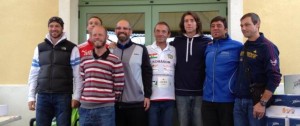 On September 8, 2013, 21 competitors from 12 countries toed the line to compete in one of the world’s most epic experiences. So epic, according to Wayne Kurtz of Pittsburgh, Penn., it would be one they’d never experience again. “This was a one-time gig,” he said.
On September 8, 2013, 21 competitors from 12 countries toed the line to compete in one of the world’s most epic experiences. So epic, according to Wayne Kurtz of Pittsburgh, Penn., it would be one they’d never experience again. “This was a one-time gig,” he said.
Only 28 athletes from around the world were invited to participate in the 30 x Ironman, or the “Triple Deca IRON”. To prequalify, athletes needed to have at least one Deca IRON under their belt…and for good reason: the next step, from 10 days to 30 days, is quite a leap.
During the course of the Deca Ironman race, held in Paschiera Del Garda, Garda Lake in Italy, athletes swam a total of 72 miles, cycled 3,360 miles, and ran 786 miles. On race day, 21 athletes started the journey of a lifetime; in the end, only 8 finished, earning a Guinness World Record for finishing the world’s longest IRON distance competition.
Unfortunately, the only female to join the guys, Danish competitor Thea Storm Henriksen, became sick with the flu and was forced to drop out after one Ironman.
While there were 21 athletes working to complete the 30 x Ironman, numerous other athletes from around the world were in Italy to compete in the following races, which were going on concurrently:
20 x Ironman
30 x Olympic distance Ironman
10 x Ironman (the Deca IRON)
5 x Ironman (Quintuple IRON)
The 30 x Ironman has been the focus of the race coverage, but these other athletes, an additional 20 or so, were there to prove their worth in the field of endurance racing – only 3 of them women.
As you can imagine, a story behind this the 30 x Ironman event is in the works. Endurance athlete, Wayne Kurtz and fellow record-holder for the 1X30 Olympic distance triathlon, Stefan Zetterström, co-authored the new book “Stronger than Iron” will be published the Spring of 2014.
http://www.post-gazette.com/news/healthscience/2013/10/28/Ironman-finishes-grueling-race/stories/
]]>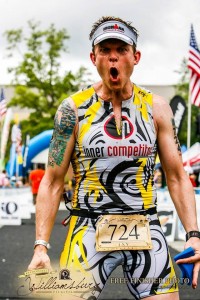 Inner Competitor® Training, Part 1
Inner Competitor® Training, Part 1
Mental ability, also referred to as mental toughness, can be confusing and difficult to define, and is complicated by how elusive it is to train to improve. Yet mental ability is paramount to an athlete and is an area that requires focus in order to improve overall performance.
So let’s try an approach to mental ability to make it simple and powerful. Start with the assumption that our ultimate goal is to accomplish performance improvement and enhance our enjoyment of the sport. If so, then we are guided to find practical and applicable tools – which just so happen to be in the domain of mental ability – that help us achieve that goal.
This series of articles is based on that approach – focusing on the goal of improved performance and enhanced enjoyment of the sport, within the context of mental ability. The framework the articles will follow is based on the sciences and processes of Leadership Coaching.
Let’s begin by asking yourself a few questions.
What is your honest opinion of yourself as an athlete?
When do you find yourself struggling the most?
What do you hear yourself saying when things are not going well during training or racing?
We’ll come back to those questions later. First, let’s talk about an important component of mental ability: your brain.
Here is something every athlete should know: One of the key design principles of the brain is minimize danger and maximize reward. The simplified version is that our brain identifies something as “bad” with a subsequent avoidance strategy, and “good” with a subsequent engagement strategy. Hot stove = bad, avoid.
The way the brain accomplishes avoiding “bad” and engaging “good” is through the mechanism of story (inner voice) and emotion. The brain assesses “bad” and wants us to avoid it; the brain creates a story, and your inner voice starts yelling about it. You will experience some kind of emotional response; emotion is the fuel of action. So before you know it, you are faced with a loud inner voice, an emotion, and fuel to act. Example: Brain assesses hot stove, inner voice yells “Holy crap, ouch”, response is emotion of fear, lots of fuel kicks in and the hand is quickly pulled back from the burner. Fast; efficient.
 Here is the kicker, and why we care as athletes: our brain is quick to assess “bad”, and there is a lot of potential for “bad” as a performing athlete – physical pain (keeping up this running pace), perceived loss (falling short of goals), something important at risk (my identity as an athlete), unexpected challenge (weather, equipment issues), foes (competitors), loss of control (course conditions), winning/losing, and so on. Performing in sports is one big adventure in dealing with our brain’s auto-response to minimizing danger, inner voice, emotions, and fuel to act in ways that counter our peak performance. This auto-response is the root of what derails the best of athletes if gone unchecked.
Here is the kicker, and why we care as athletes: our brain is quick to assess “bad”, and there is a lot of potential for “bad” as a performing athlete – physical pain (keeping up this running pace), perceived loss (falling short of goals), something important at risk (my identity as an athlete), unexpected challenge (weather, equipment issues), foes (competitors), loss of control (course conditions), winning/losing, and so on. Performing in sports is one big adventure in dealing with our brain’s auto-response to minimizing danger, inner voice, emotions, and fuel to act in ways that counter our peak performance. This auto-response is the root of what derails the best of athletes if gone unchecked.
The great news: our brain is trainable! There are methods and approaches athletes can employ to improve performance and enjoy the sport more by managing through the danger-story-emotion-fuel mechanism.
Let’s define the first practical and applicable action to improve your performance. And remember, this is a coaching process – which means step one is step one: The first action on your Inner Competitor® training plan is called noticing – focusing your attention on yourself and your experience. Become intimately familiar with your inner voice and the conditions and experiences that are present. Notice what your brain is labeling as “bad” or “good.” Notice what you say to yourself, notice when you say it, notice everything that you can during the danger/reward-story-emotion-fuel response. You can’t do anything to change the response until you notice it.
You actually have already started this. Recall your answers to the questions at the beginning of this article. What does this suggest about your danger/reward-story-emotion-fuel process?
In the next article, we will continue in the coaching process by building on our noticing. We will learn tools to train ourselves (our brain) in order to improve our performance and enjoy the sport more.
Until then, rock!
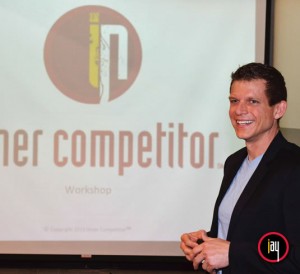 Jay Markiewicz an endurance athlete and highly sought-after Fortune 500 Leadership Coach, Sports Performance Coach, and founder of Inner Competitor® – an organization that works with clients who want to perform better and enjoy their life more. You can contact Jay at [email protected].
Jay Markiewicz an endurance athlete and highly sought-after Fortune 500 Leadership Coach, Sports Performance Coach, and founder of Inner Competitor® – an organization that works with clients who want to perform better and enjoy their life more. You can contact Jay at [email protected].
]]>
Rebekah Trittipoe vividly remembers the 160-mile Brazil Jungle Marathon back in 2003: Six days of racing alone in the hot and humid Amazon made the veteran runner stronger, both physically and mentally.
“It was an amazing experience,” said 56-year-old Trittipoe. “That was really a big step for me. I would love to do it again.”
BRAZIL JUNGLE MARATHON
Different from other ultramarathons she has run in the past 10 years, the six-stage Brazil Jungle Marathon was self-supported, and Trittipoe had no idea what to expect or how to prepare for it; the only thing she knew was that she wanted to do it. “I was very excited, because I’d been looking for something people would call crazy and stupid,” said Trittipoe.
After saying goodbye to her husband and children, Trittipoe was on her way to another hemisphere with a back- pack filled with food packages, two pairs of socks, and some clothes.
Armed with only the backpack, a map and some water, Trittipoe began the adventure with another 40 athletes from all over the world. “Even though it was called marathon, it’s really hard to run because you carry all your supplies; I felt like I was a turtle with all the things on my back,” she recalled.
In the pungent 100-degree jungle, Trittipoe got wet by hiking through swampy areas. Some people developed funky skin rashes on their legs. “Every time you went through a swamp, you thought, ‘Oh my goodness, what’s in there? Would it eat me?’ ” she said.
At one point, Trittipoe found herself lost in the jungle when the red ribbons tied along the not-so-established trail disappeared, and the map was not really helpful. “I had no idea where to go,” she said. “It was really frustrating. I was yelling, ‘God! I need some help!’ ” Luckily, a man heard Trittipoe and got her back on track.
At another point, she was the helper: Trittipoe shared water with a woman from England who had completely run out. Trittipoe herself was dehydrated and exhausted, which made it even harder to race. “One of the things I learned from the Brazil race is that you have to be very, very flexible, because what you might expect to happen doesn’t always happen,” she said. “Sometimes you just have to suck it up and deal with the cards you’re handed and do what you can.”
Trittipoe and the other runners camped near water every night. She cleaned herself and washed the clothes she was wearing and hung them up. Darkness came quickly in the jungle; there was nothing to do other than organize stuff for the next day and chat with fellow athletes, then try to get to sleep in the noisy outdoors. “You would think the jungle is quiet, but it’s not. It’s very loud. You get used to it,” said Trittipoe. In the morning, they woke up early and retrieved their not-quite-dried items and put them back in their packs. A new day began again.
“You certainly went through phases you hated, because it was so difficult and you were suffering. I just could not allow myself to come that far, flying all the way from a different continent, to quit. I had to finish it,” said Trittipoe.
Six days later, Trittipoe got to the finish line. She was the first American to finish the race, and second overall. “All I wanted was an ice-cold Coke,” she said. “The world became wonderful again. I finally could get a shower. It’s wonderful to have a clean bed to sleep in and a room with air conditioning.”
RUNNING CAREER AND LIFE
Trittipoe had been an athlete since high school, where she played hockey, volleyball, and tennis. And yet she never thought of running long distance until she was 36, and challenged by well-known ultrarunner David Horton that she would not be able to run 50 miles. “I thought ‘Fine, I’ll show you.’ That’s when I started running and training for long distance,” recalled Trittipoe. Her first race was the 1994 Catoctin Trail 50K—and she won.
Trittipoe suffered multiple injuries on her feet and ankles for the first five years. After going through the hardships, she adjusted her training and hasn’t been injured since. “There’s always difficulty,” she said. “I had to train in a way that is good for me. I can’t do 80, 90, or 100 miles per week. And you also have to figure out what suits your life situation. My highly stressful medical career was really demanding on my time. I had to readjust my priorities to make sure I keep everything in balance.”
Trittipoe is a mother of two sons and lives with her husband in Bedford, Va. She doesn’t race as much as she did before, but she still runs ultras and trains three days a week. Once a cardiovascular perfusionist, she often found herself swamped with medical cases. She is now coaching a high school cross-country team and also teaching biology.
“Yesterday I took the cross-country team on a one-night running trip. These kids can run 17 miles now. Most of them didn’t run that much before. They embrace the idea of going out to the woods and running long miles and climbing mountains. It’s very rewarding to see them go from the impossible to the possible. I want them not just to be athletes, but to be stronger,” said Trittipoe.
She has run more than 80 ultramarathons over the years, including Catoctin 50K, Mountain Masochist 50 miler, JFK 50 Miler, The Groundhog Classic 50 Miler, Rattlesnake 50K, and the Uwharrie 40 Mile Mountain Run. She was one of six women to complete The BEAST ultramarathoning race series; was the women’s record-holder on West Virginia’s 302-mile long Allegheny Trail (7 days, 6 hours); and was the tri-holder of the women’s record on the South Beyond 6000, a nearly 300-mile long run across 5 mountain ranges with the summit of 40 peaks in excess of 6000ft. elevation (6 days, 13 hours, 31 minutes).
“I like running because I like the place it takes me,” said Trittipoe. “There are so many beautiful landscapes that can only be seen from the top of the mountain. Do I love running every day? No, I don’t. Sometimes I hate it, because you feel like crap. But you have to take the step, you have to get through those days.”
Rebekah Trittipoe is also a writer who has published four books: “Best Season Yet: 12 Weeks to Train,” “Pace Yourself,” “Under an Equatorial Sky,” and “A Quest for Adventure.” For more information, visit http://rebekahtrit- tipoe.blogspot.com/
Alexander Cochran doesn’t see himself as a runner, though he enjoys running and has completed seven marathons. His goal is to run the Boston Marathon—or to have a post-race beer.
“I won’t run Boston until I qualify,” said 46-year-old Cochran, special counsel to New York State Gov. Andrew Cuomo. “It’s a special race. In fact, if I never ran Boston but still hit the qualifying time, I’d die a happy runner.”
BOSTON STRONG RUN
Three years ago, after going through a training program and being coached by a sports therapist, Cochran was so close to the BQ (qualifying time)—but he missed it by four minutes. “I cried like a baby,” he recalled. “Now, since the bombing, I am doubling down on training so that I can run it with my friend who was almost blown up.”
The friend Cochran refers to is Jamie Hoag, who ran the Boston Marathon for the first time this April. When Cochran saw the breaking news on MSNBC, he was concerned about Hoag and hoped for the best. Luckily, Hoag was fine, and sent Cochran a picture from between the two clouds of smoke.
Cochran later had the idea of setting up a run in Hoag’s honor. “I mean, he trained his ass off for four months and was 100 feet short,” said Cochran. “The idea was to run with Jamie and let him finish the run. We would raise money for the One Fund Boston and maybe also an injured runner, and make the terrible experience a better one.”
The run was called Boston Strong Run and set up with three different distances: 5 kilometers, 4 miles, and 8 miles. Not only did Cochran recruit 4POINT4, a philanthropic brand of sports apparel, to donate shirts to all the runners, he also spent 12 hours with his child making little finishers’ medals out of Shrinky-Dinks. The medals were blue on top, gold at the bottom—the same colors as the Boston Marathon—with each runner’s initial emblazoned on a medal. Cochran asked friends of the running club and all the New York State con- gressional delegation staff to participate in the Run. The goal was to have 25 to 50 runners and raise $1,000.
On June 15, 75 people ran together at Carderock Park, Md. They raised $2,500, and contributed half to the One Fund and the other half to a runner from Boston who lost both legs in the blast. “This is an opportunity for them to connect to people in Boston and to Jamie,” said Cochran.
EARLY RUNNING EXPERIENCE
Cochran hadn’t started running until 10 years ago, when his wife Teresa was pregnant. Like many dads-to-be, Cochran was both excited and worried, and wondered if he could be a good father. So he put on running shoes—which he had bought for the bright color, not for performance—and went out for a run in the August heat. Running cleared his head and made him feel relieved. He did it again the next day.
“I never thought I could run a marathon. That seemed crazy. Then I thought of all the hell my wife was going through being pregnant; and I decided if she could do what she was doing to have a baby, then I could work up to a marathon,” said Cochran.
Moved by watching his brother run the Marine Corps Marathon three times, Cochran decided to run his first one—the Baltimore Marathon. “I did the math and hoped I could go from 60 minutes to 4 hours in 10 weeks,” he said. “It wasn’t easy, but I used my wife as inspiration and gutted it out. I made it through and ran a 4:08 pace—and I was hooked.” Cochran has since run seven marathons. His pace has improved to 3:25.
ALMOST RUNNING CLUB
Cochran enjoys running, and also tries to encourage friends to get off the couch and start running. So he founded a neighborhood running group called “Almost Running Club.”
“Everyone has an excuse for why they can’t run,” said Cochran. “So I want to create an excuse for them to run. Don’t tell me you can’t—because you can bring your kids to my house, and either my wife or I will watch them. You can run whatever distance you want, 2 miles or 10 miles. Later we will have champagne, beers, bagels, or whatever. It will be a party.”
Beginning with only 10 people, the club has grown to 30 over the years. They run on Hallmark holidays and play with the “Almost” theme: A run on Valentine’s Day is called “Almost in Love”; a run on Christmas is “Almost Frosty”; a run on Thanksgiving is “Almost Stuffed.” Every runner has a funny “Almost” nickname; Cochran got the nickname “Almost Well”, as he’s always injured by running. “We have a Boston Red Sox fan, so we call him ‘Almost Yankee’,” Cochran laughed.
“I tell you, of all the things I’ve done professionally—from law school to politics to passing the Hurricane Sandy Appropriations Act—the most gratifying thing I’ve done, with the help of my Almoster buddies, was motivating folks to get off the couch and run,” said Cochran.
Besides running together, the “Almosters” exchange daily emails to motivate each other. “At the end of the day, it doesn’t matter whether you are a runner, a jogger, or a walker,” Cochran said. “As long as they are getting out there, no excuses, and doing it, I’m proud of all of them—and hopefully I can be proud of myself. ”
JEFF BAUMAN
Jeff lost both legs in the Boston Marathon bombing. We gave him $900 and the other $1,600 went to the one fund. We wanted to have a direct connection with part of the money as opposed to just giving it to the fund so the cash that was given went to me went to Jeff and his beautiful story. the folks that wrote checks went to the fund. so with a little check to Jeff we say thank you to not only him but all of our own individual support networks for putting up with the craziness of trying to be a runner.
